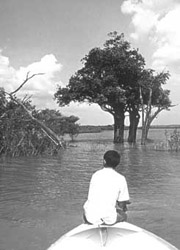The many faces of the new era of hydroelectric generation in the Amazon
 Wrapped in the triad that comprises the Amazon rainforest, climate and energy generation, economic, social and environmental aspects will be analyzed at the debate "Amazon: The Old and the New Brazilian Hydroelectric Frontier", to be held on May 14, at 2 pm, in the IEA-USP’s Event Room.
Wrapped in the triad that comprises the Amazon rainforest, climate and energy generation, economic, social and environmental aspects will be analyzed at the debate "Amazon: The Old and the New Brazilian Hydroelectric Frontier", to be held on May 14, at 2 pm, in the IEA-USP’s Event Room.
The panelists of the meeting will be Celio Bermann, professor at USP’s Institute for Energy and Environment (IEE) and who will be participating via Skype, Gustavo Tosello Pinheiro, coordinator of Intelligent Infrastructure at The Nature Conservancy (TNC) in Brazil, João Andrade, coordinator of the Iniciativa Defensa Socioambiental (an initiative for social and environmental defense) at the Center for Life Institute (ICV), and Pedro Bara Neto, researcher of the Federal University of Rio de Janeiro’s (UERJ) Study Group on the Electricity Sector (GESEL).
Organized by IEA-USP’s Environment and Society Research Group in partnership with the IEE, and the School of Arts, Sciences and Humanities’s (EACH) research group on Environmental Planning and Management (PLANGEA), both of USP, the meeting will focus on two central questions:
- What is the scenario of social and environmental conflicts and challenges to the intensification of planning hydroelectric dams in the Amazon?
- Which existing experiences in local development, environmental protection and analyzes of extreme weather events represent opportunities for the inclusion of these topics in various scales of planning hydroelectric dams in the Amazon?
THEMED DEVELOPMENTS
The Brazilian Amazon accounts for 51 % of all the hydroelectric potential of the country. However, according to Evandro Moretto, professor of EACH-USP, only a small part of this potential is exploited, since most mills in the region have been built in the 1960s and the 1970s, and in the following two decades there has been a significant expansion in infrastructure for power generation.
Only in the 2000s Brazil started to invest massively in expansion of hydroelectric capacity in the Amazon again. As pointed by Moretto, who will mediate the debate, the installation of more than 150 dams in the region is planned. The highlights are Jirau and Santo Antonio, on the Madeira River, Belo Monte, on the Xingu River, and the project of the basins of the Tapajós and Negro rivers.
According to the professor, discussions around that recovery involve a series of thematic developments - such as weather events, environmental protection and socioeconomic development - which will be addressed at the meeting. As an example, the mediator cites the period of prolonged drought this summer in Brazil, which led to the shortage of large water reservoirs in the Southeast and the Midwest, "while the gates of the plants on the Madeira were opened to let through the highest flow of the river in history in the wake of thousands homeless upstream and downstream of the dams."
Moretto also mentions the particularity of the situation of the Amazon region. On the one hand, it suffers the environmental impacts of large infrastructure projects. On the other hand, it is favored by various actions of environmental protection and local development, "which should not be neglected in planning hydropower projects, under penalty of the new plants being much more impactful and conflictive than Belo Monte already is."
EVENT
The completion of the discussion is supported by FAPESP, IEE-USP’s Graduate Program in Environmental Science (PROCAM), TNC, Brazilian Association of Impact Assessment (ABAI) and ICV.
The event will be broadcast live on the web.
